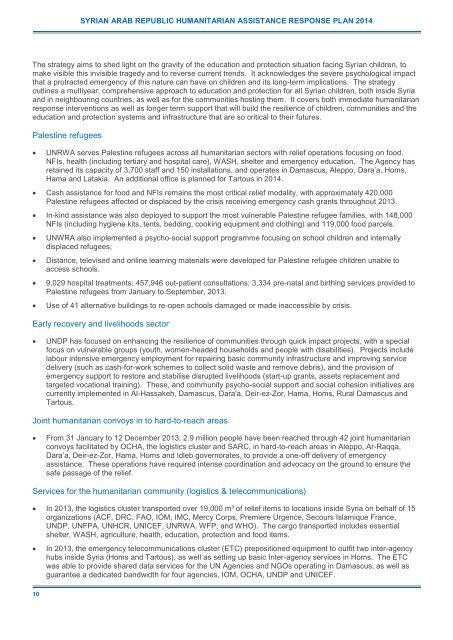2014 Syrian Arab Republic Humanitarian Assistance Response Plan (SHARP)
- No tags were found...
Create successful ePaper yourself
Turn your PDF publications into a flip-book with our unique Google optimized e-Paper software.
SYRIAN ARAB REPUBLIC HUMANITARIAN ASSISTANCE RESPONSE PLAN <strong>2014</strong><br />
The strategy aims to shed light on the gravity of the education and protection situation facing <strong>Syrian</strong> children, to<br />
make visible this invisible tragedy and to reverse current trends. It acknowledges the severe psychological impact<br />
that a protracted emergency of this nature can have on children and its long-term implications. The strategy<br />
outlines a multiyear, comprehensive approach to education and protection for all <strong>Syrian</strong> children, both inside Syria<br />
and in neighbouring countries, as well as for the communities hosting them. It covers both immediate humanitarian<br />
response interventions as well as longer term support that will build the resilience of children, communities and the<br />
education and protection systems and infrastructure that are so critical to their futures.<br />
Palestine refugees<br />
<br />
UNRWA serves Palestine refugees across all humanitarian sectors with relief operations focusing on food,<br />
NFIs, health (including tertiary and hospital care), WASH, shelter and emergency education. The Agency has<br />
retained its capacity of 3,700 staff and 150 installations, and operates in Damascus, Aleppo, Dara‟a, Homs,<br />
Hama and Latakia. An additional office is planned for Tartous in <strong>2014</strong>.<br />
Cash assistance for food and NFIs remains the most critical relief modality, with approximately 420,000<br />
Palestine refugees affected or displaced by the crisis receiving emergency cash grants throughout 2013.<br />
In-kind assistance was also deployed to support the most vulnerable Palestine refugee families, with 148,000<br />
NFIs (including hygiene kits, tents, bedding, cooking equipment and clothing) and 119,000 food parcels.<br />
<br />
<br />
<br />
<br />
UNWRA also implemented a psycho-social support programme focusing on school children and internally<br />
displaced refugees;<br />
Distance, televised and online learning materials were developed for Palestine refugee children unable to<br />
access schools.<br />
9,029 hospital treatments; 457,946 out-patient consultations; 3,334 pre-natal and birthing services provided to<br />
Palestine refugees from January to September, 2013.<br />
Use of 41 alternative buildings to re-open schools damaged or made inaccessible by crisis.<br />
Early recovery and livelihoods sector<br />
<br />
UNDP has focused on enhancing the resilience of communities through quick impact projects, with a special<br />
focus on vulnerable groups (youth, women-headed households and people with disabilities). Projects include<br />
labour intensive emergency employment for repairing basic community infrastructure and improving service<br />
delivery (such as cash-for-work schemes to collect solid waste and remove debris), and the provision of<br />
emergency support to restore and stabilise disrupted livelihoods (start-up grants, assets replacement and<br />
targeted vocational training). These, and community psycho-social support and social cohesion initiatives are<br />
currently implemented in Al-Hassakeh, Damascus, Dara'a, Deir-ez-Zor, Hama, Homs, Rural Damascus and<br />
Tartous.<br />
Joint humanitarian convoys in to hard-to-reach areas<br />
<br />
From 31 January to 12 December 2013; 2.9 million people have been reached through 42 joint humanitarian<br />
convoys facilitated by OCHA, the logistics cluster and SARC, in hard-to-reach areas in Aleppo, Ar-Raqqa,<br />
Dara‟a, Deir-ez-Zor, Hama, Homs and Idleb governorates, to provide a one-off delivery of emergency<br />
assistance. These operations have required intense coordination and advocacy on the ground to ensure the<br />
safe passage of the relief.<br />
Services for the humanitarian community (logistics & telecommunications)<br />
In 2013, the logistics cluster transported over 19,000 m³ of relief items to locations inside Syria on behalf of 15<br />
organizations (ACF, DRC, FAO, IOM, IMC, Mercy Corps, Premiere Urgence, Secours Islamique France,<br />
UNDP, UNFPA, UNHCR, UNICEF, UNRWA, WFP, and WHO). The cargo transported includes essential<br />
shelter, WASH, agriculture, health, education, protection and food items.<br />
<br />
In 2013, the emergency telecommunications cluster (ETC) prepositioned equipment to outfit two inter-agency<br />
hubs inside Syria (Homs and Tartous), as well as setting up basic Inter-agency services in Homs. The ETC<br />
was able to provide shared data services for the UN Agencies and NGOs operating in Damascus, as well as<br />
guarantee a dedicated bandwidth for four agencies, IOM, OCHA, UNDP and UNICEF.<br />
10



